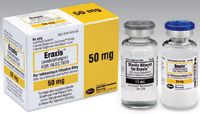New antifungal offers another option
The third echinocandin to hit the market in five years, anidulafungin (Eraxis, Pfizer) received Food & Drug Administration approval in February and joins both caspofungin (Cancidas, Merck) and micafungin (Mycamine, Astellas Pharma) in the fight against fungal infections in seriously ill patients. Anidulafungin is indicated to treat candidemia, other forms of Candida infections (intra-abdominal infections and peritonitis), and esophageal candidiasis.
TIPS TO REMEMBER ......Eraxis


"The biggest advantage is the lack of drug interactions with anidulafungin," said James S. Lewis, Pharm.D., infectious diseases pharmacy specialist and clinical assistant professor, University of Texas Health Sciences Center, San Antonio. The prescribing information states that anidulafungin undergoes slow chemical degradation at physiologic temperature and pH, and hepatic metabolism is not believed to occur. The drug is not a clinically relevant substrate, inducer, or inhibitor of P450 isoenzymes. In drug interaction studies, anidulafungin was coadministered with voriconazole, tacrolimus, amphotericin B, rifampin, or cyclosporine. No dosage adjustments were warranted for any of these drugs or anidulafungin when administered concomitantly.
Abnormal liver function tests (LFTs) have been observed with anidulafungin, as well as isolated cases of hepatic dysfunction, hepatitis, or worsening liver failure. The company recommends that patients who develop abnormal LFTs during therapy be closely monitored for worsening hepatic function.
During clinical trials, the most common side effects associated with anidulafungin included diarrhea (3.1%), hypokalemia (3.1%), and increased ALT levels (2.3%). Possible histamine-mediated symptoms have also been reported, including rash, urticaria, flushing, pruritus, dyspnea, and hypotension. The company said these events are infrequent when the rate of infusion does not exceed 1.1 mg/min.
Despite advances in antifungal therapy, mortality from candidemia remains very high, and Candida is the fourth most common pathogen isolated in bloodstream infections, Carver pointed out.
Lewis agreed that it is a very serious condition. "The addition of another well-tolerated compound to the armamentarium for severe Candida infections is always welcome," he concluded.
Targeted Drug Combination Reveals New Activity in Brain Tumors
December 28th 2021A combination of two targeted cancer drugs showed unprecedented, “clinically meaningful” activity in patients with highly malignant brain tumors that carried a rare genetic mutation, according to a clinical trial report by investigators from Dana-Farber Cancer Institute.